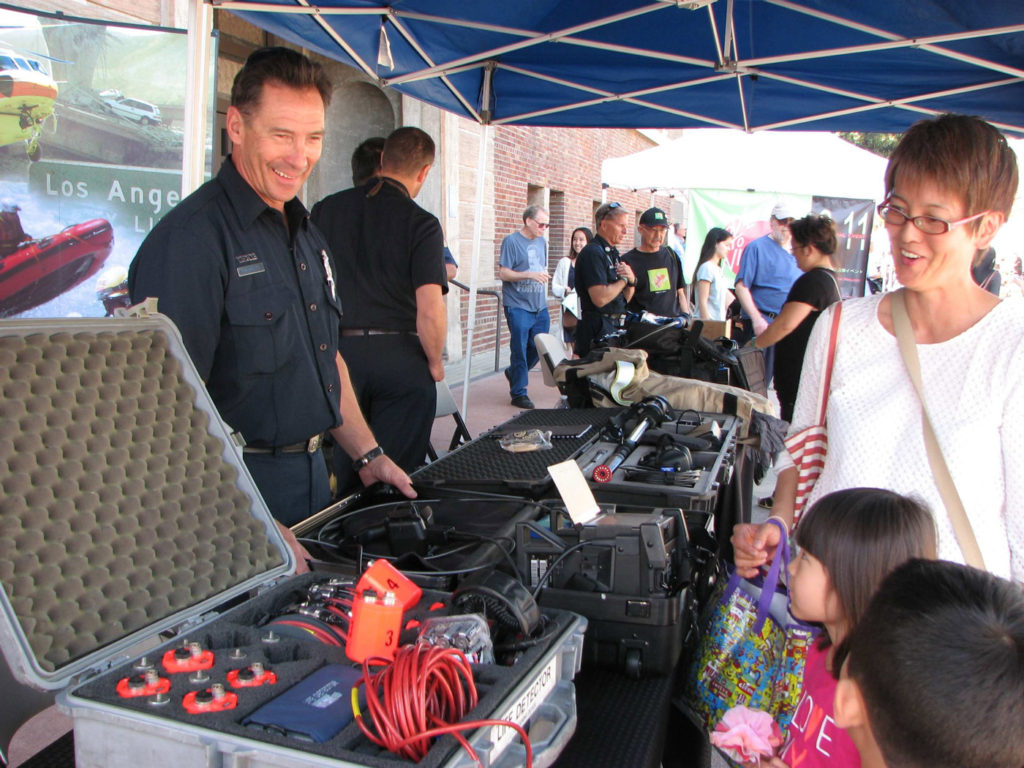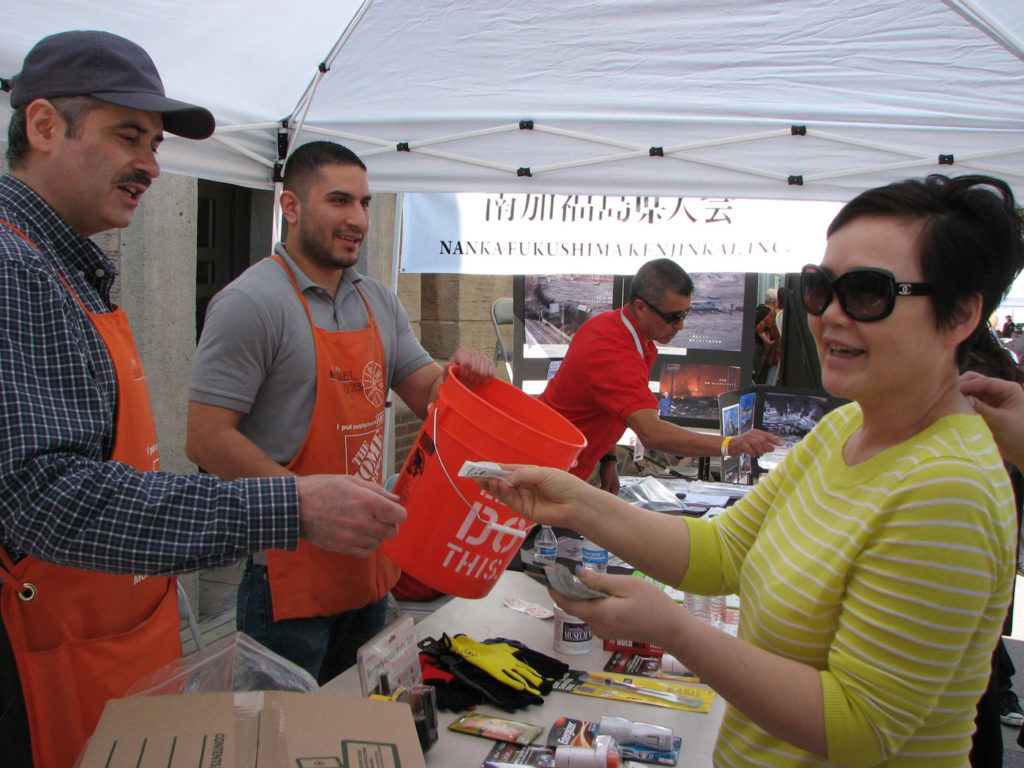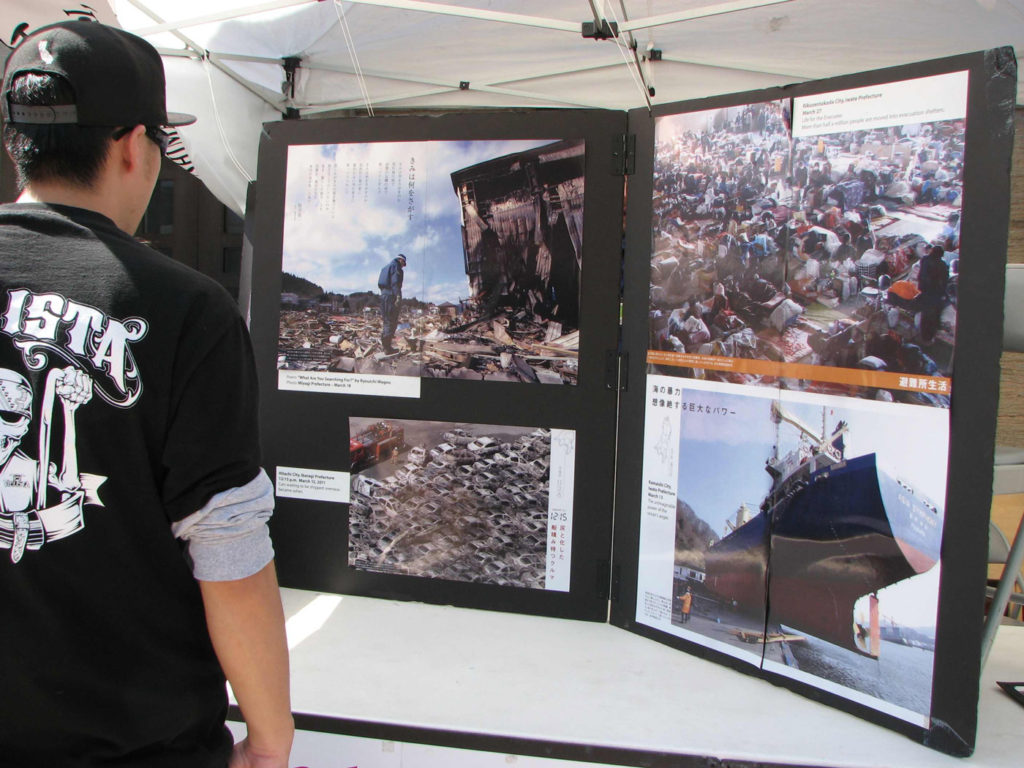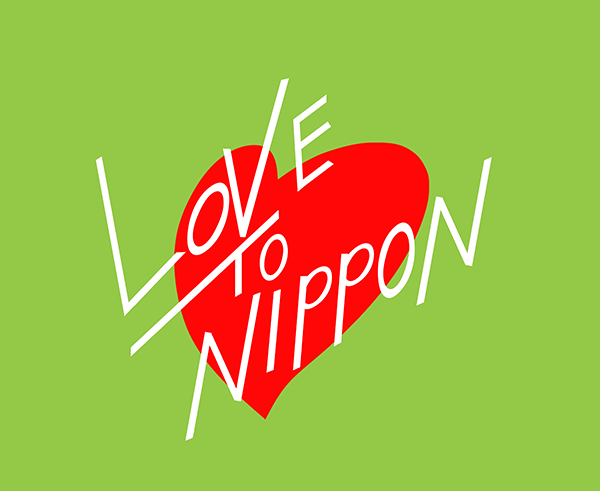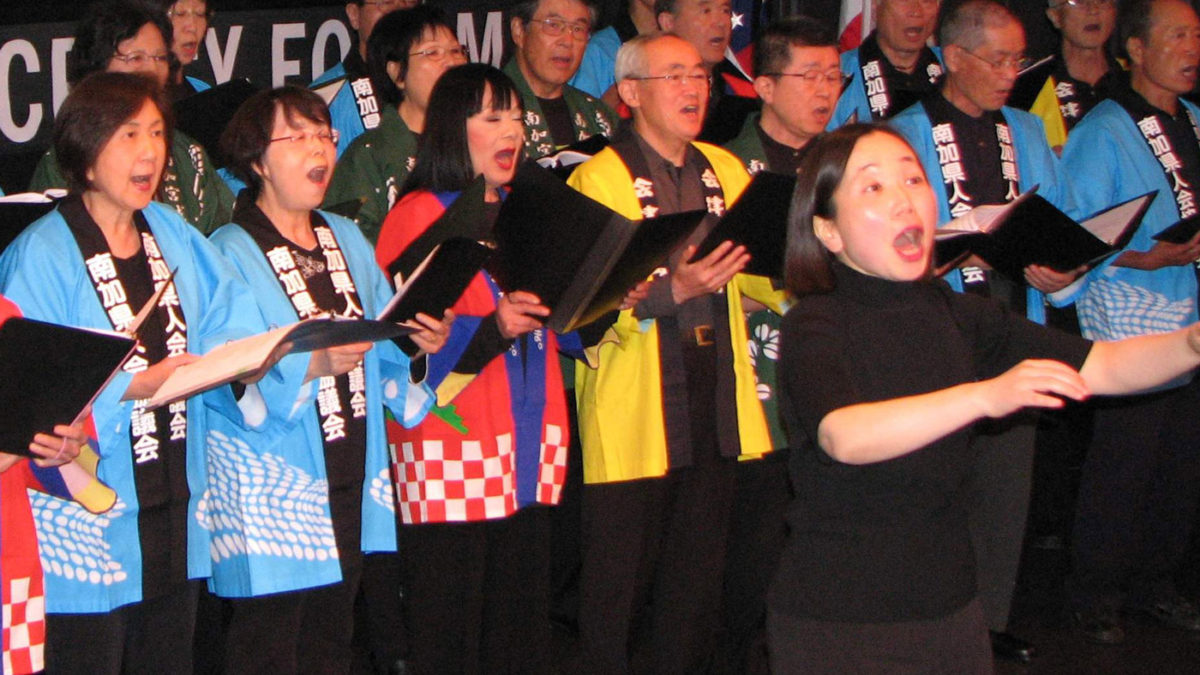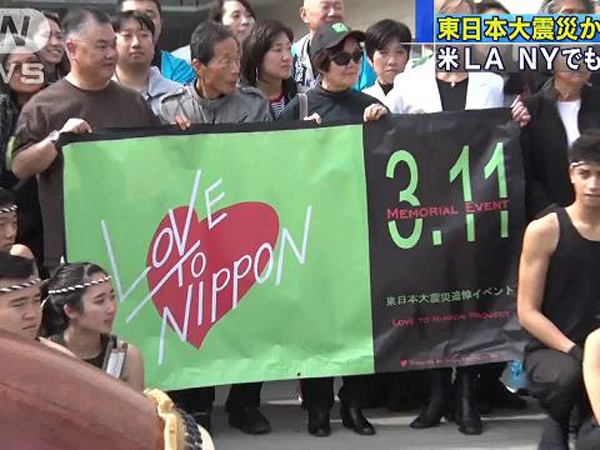The fourth anniversary of the earthquake and tsunami in northeastern Japan is remembered in L.A.
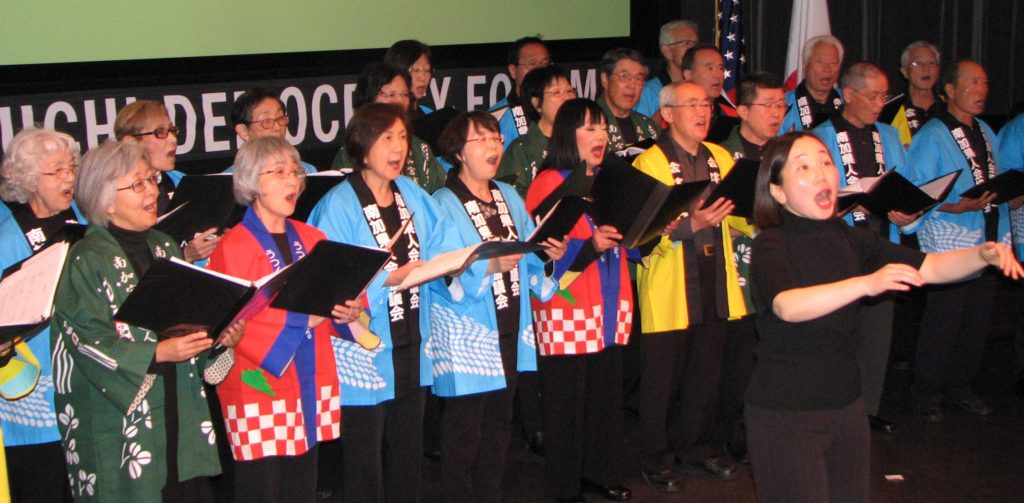
By J.K. YAMAMOTO, Rafu Staff Writer
The fourth annual Love to Nippon, a commemoration of the earthquake and tsunami that devastated northeastern Japan on March 11, 2011, was held March 8 at the Japanese American National Museum in Little Tokyo.
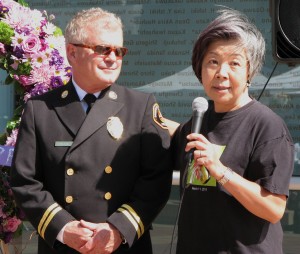
Known as the Great East Japan Earthquake or simply 3.11, the disaster claimed more than 18,000 lives and left more than 200,000 people homeless. The region is slowly recovering, but many people are still displaced.
The outdoor portion of the program, which included an emergency preparedness fair and music by Los Angeles Todo-Kai, took place in the JANM Courtyard and Plaza. The Miyagi, Iwate and Fukushima kenjinkai, representing the prefectures hardest hit by the tsunami, had booths, as did the L.A. County Fire Department, U.S. Coast Guard, American Red Cross, and Home Depot.
L.A. County Fire Department Chief Daryl Osby noted that his department’s Urban Search and Rescue Team responded to the disaster. “Since then, between our department and the citizens of the areas of Japan that were affected by that devastating earthquake and tsunami, we’ve maintained a continuous relationship and partnership.”
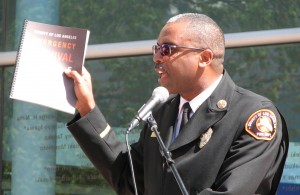
Osby, who saw the aftermath of Hurricane Katrina in 2005, reminded the audience that Los Angeles is overdue for a major earthquake. “The time to be prepared is prior to the incident, not during the incident … Think about your daily life, think about everything that’s normal — electricity, running water, grocery stores … gas stations, banks, communication systems, sanitation. All the things that you think are normal … stop in an earthquake.”
He urged everyone to stock up on emergency food, extra medication, a radio and other supplies, and to have an evacuation plan. Since first responders will be overwhelmed by a major disaster, he added, volunteers who have trained for emergency preparedness can help protect lives.
Battalion Chief Larry Collins, who was part of the Urban Search and Rescue Team sent to New Zealand and Japan in 2011, said he has been working on tsunami preparedness for coastal areas of L.A. County. “Even with the very elaborate warning systems that Japan has instituted for decades and the fantastic public education program in Japan and the readiness of first responders … there was tremendous life lost … a warning that you can never be too prepared,” he said.
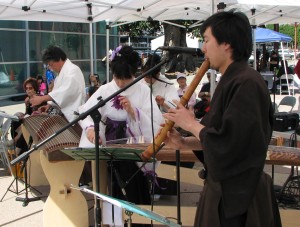
Thanks to the late Jeff Terry of the L.A. County Office of Emergency Management, a plan was already in place when there were fears that the Japan tsunami could reach the West Coast, Collins said. “It was activated and evacuations did occur, beaches were closed … Fortunately there was no life lost in California, except in the Crescent City area … We know we dodged a bullet.”
But he warned that there could be a “locally generated” tsunami resulting from an earthquake or underwater landslide. “The lives lost (in Japan) were tragic; the bigger tragedy would be if we didn’t learn lessons from that event so that we can save lives in the future.”
Two-Time SurvivorTwo-Time Survivor
Masako Unoura-Tanaka, who co-emceed the outdoor program with Richard Fukuhara, is the founder of Love to Nippon and a two-time tsunami survivor. She was in Kesennuma, Miyagi Prefecture four years ago and managed to get to the top of a tall building. In 1960, when she was 5, the area was hit by a tsunami that originated in Chile.
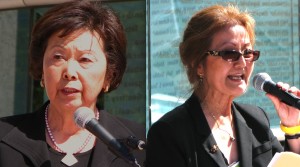
She recalled that in 1960 the fishermen saw the water receding and knew it was a warning sign of a tsunami. They warned the townspeople, but not everyone evacuated. “If fishermen didn’t help me and my dad, we would be all gone,” she said.
Noting that her 90-year-old father has survived three tsunamis, Unoura-Tanaka said there is an old Japanese saying, “Nikai aru koto wa sankai aru,” meaning that if you experience something twice, there is likely to be a third time.
Lawrence Shih, representing Supervisor Hilda Solis, paid tribute to the deceased and those who lost loved ones with remarks in both English and Japanese.
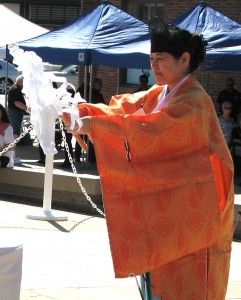
With introductions by Kay Inose and Kitty Sankey of the Japanese Women’s Society of Southern California, an interfaith service was conducted by Izumi Hasegawa, senior priest of Shusse Inari Jinja; the Nikkei Interfaith Group of Little tokyo and Los Angeles Buddhist Temple Federation; and Rev. Mark Nakagawa of Centenary United Methodist Church.
Members of the audience paid their respects by offering flowers and incense.
The indoor program was held at JANM’s Tateuchi Democracy Forum with Janet LeBlanc of Love to Nippon Project as emcee. She said that the organization seeks to make March 11 an official emergency preparedness day in Southern California and is working with the Mayor’s Office toward that end.
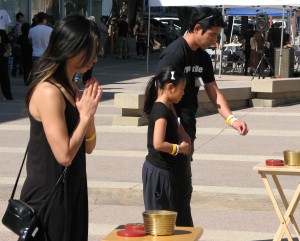
A video was shown of students at Kitakami Elementary School in Miyagi Prefecture singing their school song. A moment of silence was observed for the victim. Erika Olsen sang the U.S. and Japanese national anthems.
Rev. Timothy Yee of Union Church of L.A. gave the invocation and Cantor Eva Robbins of N’vay Shalom Synagogue sang a song. “It is the actions we take, what we do with our lives that brings blessing to those who are gone … Memorial is about taking the past and creating a better future,” she said.
JANM President and CEO Greg Kimura, a Yonsei and a fourth-generation Alaskan, said the commemoration was very meaningful to him. “In 1964 on Good Friday, the largest earthquake and tsunami ever recorded occurred in Alaska. My father at the time was a university student in the Lower 48 and it took three weeks before he would find out if anybody in the family had survived that horrific event … Of course on many different levels, I and my family felt a very close affinity and sympathy for the people in the affected areas (in Japan).”
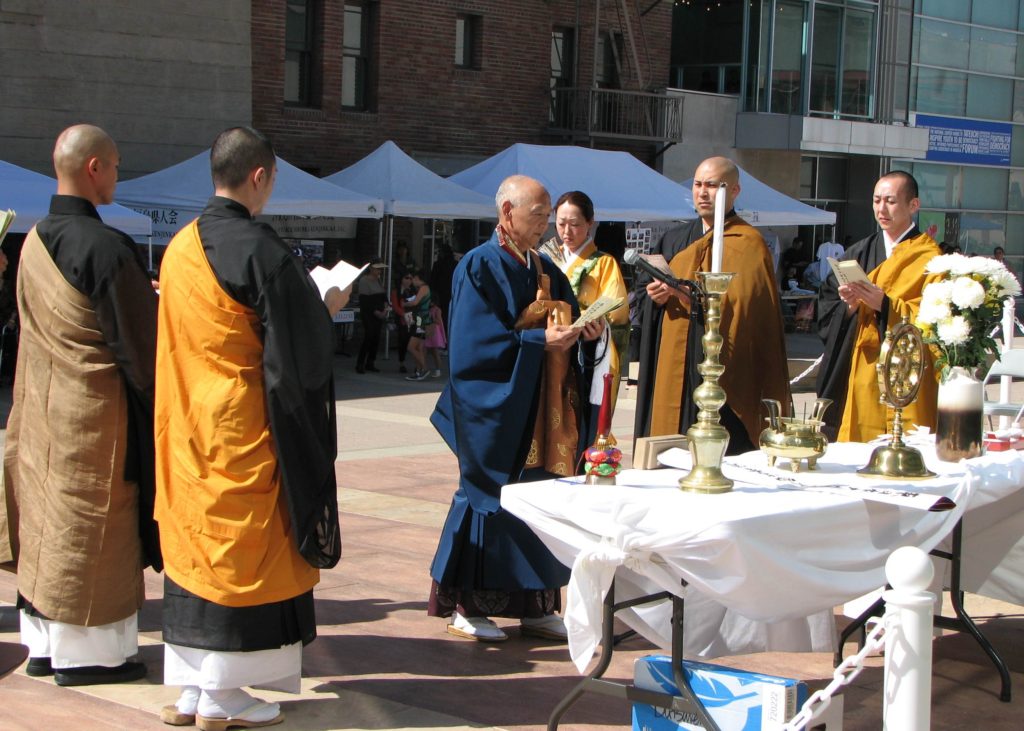
Helping the Survivors
Doug Erber, president of the Japan America Society of Southern California, said that the JAS has helped Japan after the Great Kanto Earthquake, which hit Tokyo in 1923; Typhoon Vera (or Isewan), which struck Nagoya in 1959; and the Great Hanshin Earthquake, which hit Kobe in 1995.
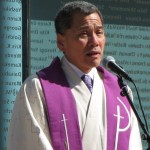
In response to 3.11, the JAS put people in touch with the Red Cross, the State Department and the Embassy of Japan, and started a relief fund that has raised $1.5 million, Erber said, and last September, a17-member delegation that included Chairman Terry Hara went on a goodwill tour through Tohoku, including Ofunato (Unoura-Tanaka’s hometown), where a fishing pier was rebuilt. JASSC and the Asia America Symphony also donated musical instruments to elementary and junior high schools.
“In Fukushima, we visited Fukushima Aiikuen … a 122-year-old orphanage that is home to 92 children, ages 2 to 18,” Erber said. “They’re on a hill just outside the (nuclear) evacuation zone. So for two years the children under 5 years old couldn’t go outside at all. The older children were only allowed to go on the decontaminated roads to go to school and back. So we’ve been supporting them … providing opportunities for them to do things indoors.”
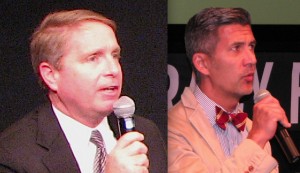
Perry Moreth, senior vice president of global banking for Wells Fargo, and his wife Michelle, both members of JASSC, visited Japan for the first time to see the devastation in Tohoku first-hand. To give an idea how widespread the destruction was, Mr. Moreth it was as if a tsunami had wiped out Huntington Beach going all the way to the 405 Freeway.
“When we met with some of the kids in the schools and at the orphanages … they were having so much fun,” he said. “At some level they had healed or at least they were going through the healing process. I was very relieved to see at some level kids being kids.”
But when the couple met with fire and rescue teams in Ofunato, “You could just see it in their eyes, a certain sadness, especially when they replayed some of the video for us of the devastation. I could tell that they were still very much in pain … That healing process, I don’t know how that will ever be managed.”
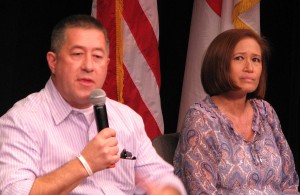
Michelle Moreth commented, “It’s one thing to see it on TV or hear about it on the news. It’s such a different thing to actually be there … and meet with the people who survived it … It made it so much more real and emotional and heartbreaking …
“We met a husband and wife who had lost all three of their children, and we spent half a day with them … I kept thinking, how do you recover from that?”
Although it was a draining experience, she said, “There was just so much to see and so many people to visit, and everyone was so welcoming to us and thankful for what the JAS has donated to try to help them recover … There’s a lot to be done still, but we were very honored and privileged to be there.”
Although it was a draining experience, she said, “There was just so much to see and so many people to visit, and everyone was so welcoming to us and thankful for what the JAS has donated to try to help them recover … There’s a lot to be done still, but we were very honored and privileged to be there.”
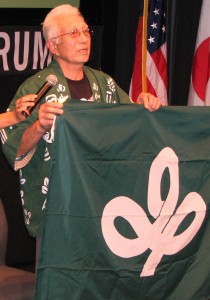
Yoshihito Yonezawa, president of Miyagi Kenjinkai, visited Ishinomaki and other towns in the prefecture and discussed reconstruction plans with the governor. “I’m doing as much as I can” to help out, he said.
He also talked about Taylor Anderson, who taught English in Ishinomaki through the JET (Japan Exchange and Teaching) Program and became a casualty of the tsunami.
Yonezawa and Unoura-Tanaka held up the flags of Miyagi, Iwate and Fukushima.
“A Lot to Be Done”
Architect Ted Tanaka, Unoura-Tanaka’s husband, recalled that his wife “spent 12 hours up on the roof in Kesennuma surrounded by tsunami. I was in Marina Del Rey and luckily I had a 20-second conversation with her from a cell phone … She said, ‘Ted, I might die.’ Then I lost her for the next 48 hours, and thank God she was saved and she called me 48 hours later from hospital. Since then our lives have never been the same.”
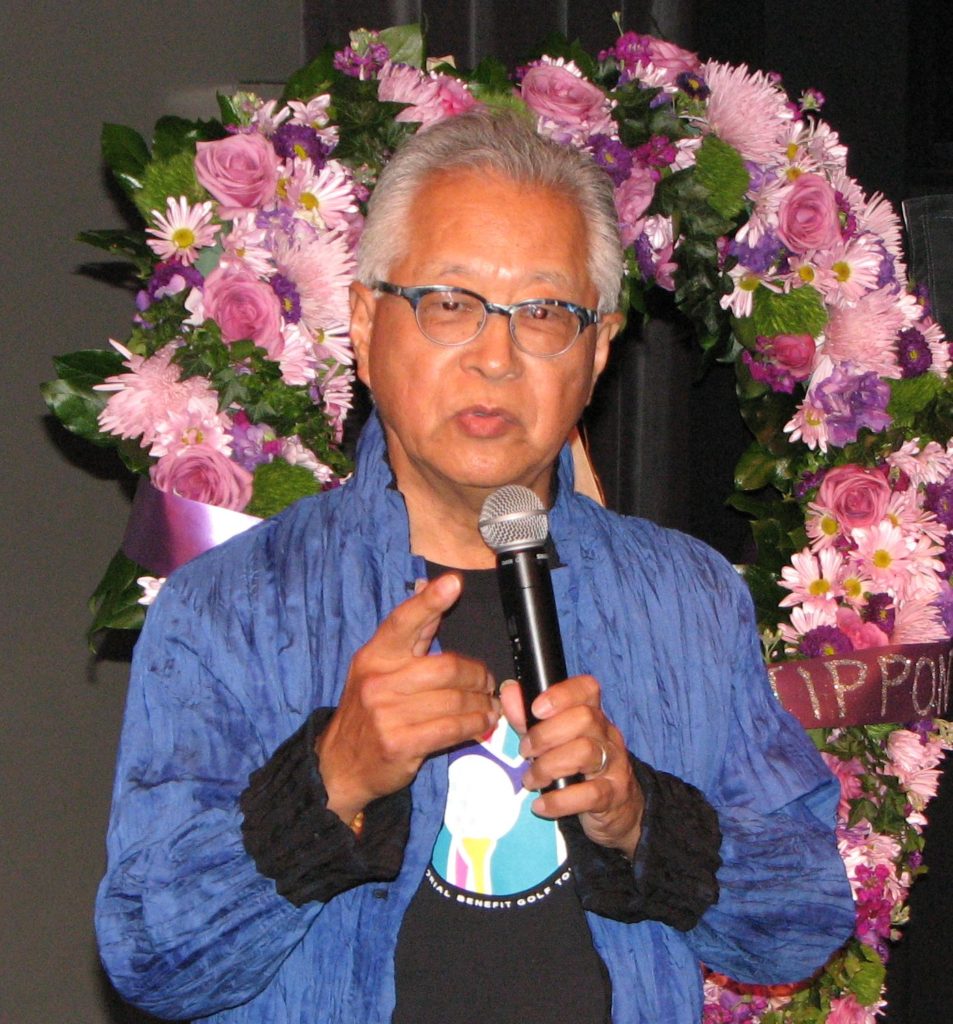
Showing slides from his last trip to Tohoku, Tanaka said that he and his wife visit Ofunato about three times a year, and even now they feel “very sad and devastated” when they hear survivors’ stories.
He slept in one of the temporary shelters for survivors and felt sorry “for these people who are spending another very cold winter … There is a lot to be done yet.”
A concert with the Asia America Symphony and pianist Keiko Matsui raised $25,000 for musical instruments to be donated to students in Ofunato, and Tanaka announced that the third 3.11 Memorial Golf Tournament will be held on Oct. 2, with proceeds going to sports programs in the area.
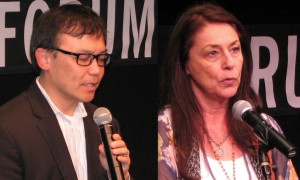
Filmmaker Regge Life, whose documentary “Live Your Dreams: The Taylor Anderson Story” was screened later that day, said, “Usually when I’ve done screenings of this film, I travel with Andy Anderson, who is Taylor Anderson’s dad, and sometimes with Jean, her mom. Andy couldn’t be here today but he wanted me to share just a few words with you …
“Most of all he wants everyone to know that though Taylor, his daughter, and Monty Dixon, the other American who was based in Rikuzentakata, are chronicled in the film primarily, for both of us it has been our intention from the beginning that this film is a memorial to all of the people who were taken from us on 3.11 …
“In all the screenings that I do this month — I go from here to Seattle and Portland, Andy’s in Cincinnati tomorrow, and there’s another screening in Detroit going on simultaneously — we do this as a way for people not to forget Tohoku.”
Foundations have been established in the two teachers’ names with the goal of “continuing bridge-building, continuing redevelopment and rejuvenation of the area,” he said.
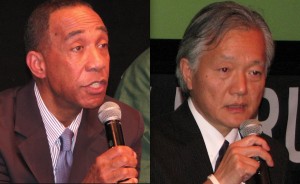
This marks the fourth film about Japan that Life has produced in the last 26 years, with a fifth on the way.
Consul General Harry Horinouchi said of Anderson and Dixon, “I’m quite sure that their generous spirit will live on forever.:
Horinouchi, who recently met in Los Angeles with Koichi Tani, special advisor to the minister for reconstruction, said, “He had two messages. One is that … historically we have experienced so many natural disasters — typhoons, earthquake, tsunami and volcano eruption — but each time we have overcome … Second message is that we will never forget the kind and strong support from the U.S. and the American people … so let us join forces and work together to build a better future.”
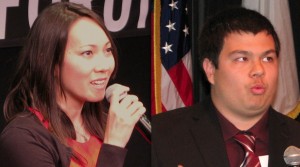
Kevin Murphy, student from Cal State Northridge, recited a poem that he wrote in Japanese, “Gambarou,” which urged the people of Japan to persevere.
The Nikkei Choral Federation of Southern California — which consists of Sakura Chorus, Mori no Kai, Cosmos, Cappella Opus and L.A. Men’s Glee Club, sang “Hana wa Saku” (Flowers Will Bloom), which has become an anthem for the survivors, and the folk song “Soran Bushi.”
Unoura-Tanaka announced that next year’s Love to Nippon will be held on March 6 at LAPD Headquarters, where the last three programs were held.
Photos by J.K. YAMAMOTO/Rafu Shimpo
